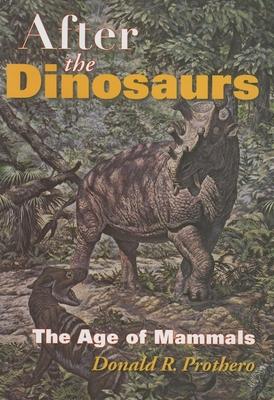Perhaps nudged over the evolutionary cliff by a giant boloid striking the earth, the incredible and fascinating group of animals called dinosaurs became extinct some 65 million years ago (except for their feathered descendants). In their place evolved an enormous variety of land creatures, especially the mammals, which in their way were every bit as remarkable as their Mesozoic cousins.
The Age of Mammals, the Cenozoic Era, has never had its Jurassic Park, but it was an amazing time in earth's history, populated by a wonderful assortment of bizarre animals. The rapid evolution of thousands of species of mammals brought forth gigantic hornless rhinos, sabertooth cats, mastodonts and mammoths, and many other creatures--including our own ancestors.
Their story is part of a larger story of a world emerging from the greenhouse conditions of the Mesozoic, warming up dramatically about 55 million years ago, and then cooling rapidly so that 33 million years ago the glacial ice returned. The earth's vegetation went through equally dramatic changes, from tropical jungles in Montana and forests at the poles, to grasslands and savannas across the entire world. Life in the sea also underwent striking evolution reflecting global climate change, including the emergence of such creatures as giant sharks, seals, sea lions, dolphins, and whales.
After the Dinosaurs is a book for everyone who has an abiding fascination with the remarkable life of the past.

Perhaps nudged over the evolutionary cliff by a giant boloid striking the earth, the incredible and fascinating group of animals called dinosaurs became extinct some 65 million years ago (except for their feathered descendants). In their place evolved an enormous variety of land creatures, especially the mammals, which in their way were every bit as remarkable as their Mesozoic cousins.
The Age of Mammals, the Cenozoic Era, has never had its Jurassic Park, but it was an amazing time in earth's history, populated by a wonderful assortment of bizarre animals. The rapid evolution of thousands of species of mammals brought forth gigantic hornless rhinos, sabertooth cats, mastodonts and mammoths, and many other creatures--including our own ancestors.
Their story is part of a larger story of a world emerging from the greenhouse conditions of the Mesozoic, warming up dramatically about 55 million years ago, and then cooling rapidly so that 33 million years ago the glacial ice returned. The earth's vegetation went through equally dramatic changes, from tropical jungles in Montana and forests at the poles, to grasslands and savannas across the entire world. Life in the sea also underwent striking evolution reflecting global climate change, including the emergence of such creatures as giant sharks, seals, sea lions, dolphins, and whales.
After the Dinosaurs is a book for everyone who has an abiding fascination with the remarkable life of the past.